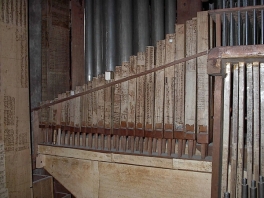

Cariñena
Bartholomé Sanchez 1734
Although an organ has existed in Cariñena since the 15th century nothing more is known about the early history there. When Bartholomé Sanchez of Zaragoza built his organ in 1734 he obviously used many pipes of previous 16th and 17th c. organs, the case, wind chests and key action were certainly made by Sanchez who also built organs in Calamocha in 1720 and in Albarrazín 1732.
All the wooden pipes are covered with paper from dissolved manuscripts and prints of the 16th and 17th centuries, internally placed in chromatic order. The quality of the older metal pipes is remarkable, many made of 100 % tin. The key action is made exceptionally simple with radial wires linking keys and pallets.
Repairs occured in 1782 and several times during the 19th and 20th centuries, but apparently without major changes. In 1997 the organ was restored by Claudio and Christine Rainolter, with 2 new bellows as well as a blower, and a reconstructed keyboard.
Music sample:
Joseph Ximenez : Batalla de 6° tono
played by Montserrat Torrent
Specification
Órgano mayor: Hauptwerk (C,D-c3, divided at c1/c#1)
bass | treble | |
Flautado mayor | 1 |
Flautado mayor |
Octava | 2 | Octava |
Octava | 3 | Octava |
Quincena | 4 | Quincena |
Quincena | 5 | Quincena |
Diezinovena | 6 | Diezinovena |
Lleno 5f. | 7 | Lleno 5f. |
Cimbala 4f. | 8 | Cimbala 4f. |
Violón | 9 | Violón |
Nasardo 12na | 10 | Nasardo 12na |
Nasardo 17na | 12 | Nasardo 17na |
13 |
Corneta Magna 7f. | |
Trompeta Real | 14 | Trompeta Real |
15 | Trompeta Magna | |
Bajoncillo | 16 |
Clarín Claro |
Trompeta en 8a | 17 | Clarín Claro |
Clarín en 15na | 18 | Clarín de Campaña |
19 | Flauta Trabesera |
Órgano de Cadereta (C,D-c3, divided at c1/ c#1 )
| Violón | 20 | Violón |
| Octava | 21 | Octava |
| Quincena | 22 | Quincena y Diezinovena 2 f. |
| Diezinovena | 23 | |
| Lleno 4f. | 24 | Lleno 4f. |
| Nasado en 12na | 25 | |
| 26 | Flautado en eco | |
| 27 | Corneta en eco 5 f. | |
| 28 | Violín en eco |
Pedal (C, D-B)
Contras de 26 palmos
Tambor y Pajarillos
Pitch: a 1 = 425 Hz at 23° C; mean tone temperament according to original pipes.
© Greifenberger Institut für Musikinstrumentenkunde | info@greifenberger-institut.de





